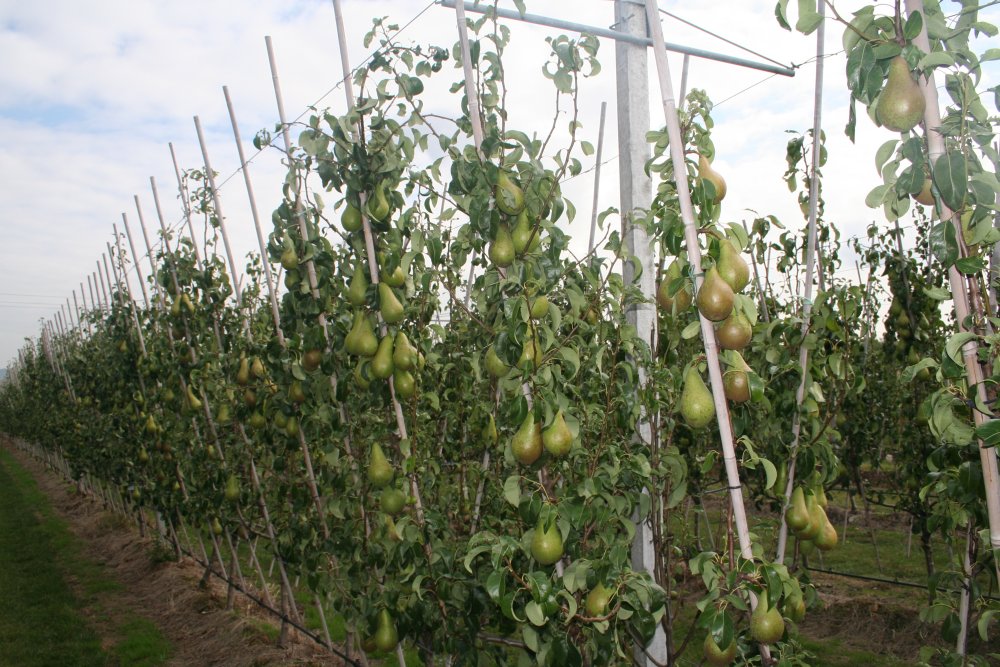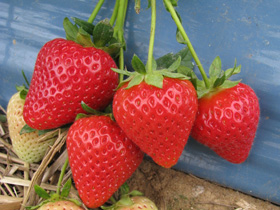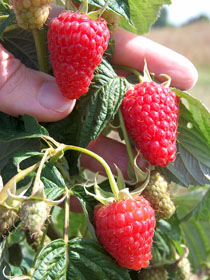

At this time of the year, it is a time to look ahead at possibilities for the future. On Thursday of last week, The English Apple Man joined his fellow members at The BEST Group 'monthly meeting at Marden Hockey Club.
 We meet on a monthly basis during the depths of winter; a speaker brings us up to date with new developments in our industry, in the company of circa 30 members and over a pint of Kent's Best Bitter!
We meet on a monthly basis during the depths of winter; a speaker brings us up to date with new developments in our industry, in the company of circa 30 members and over a pint of Kent's Best Bitter!
 Our speaker was Felicidad Fernández-Fernández (popularly know as Feli) a plant breeder and molecular geneticist in the Genetics and Crop Improvement Programme at East Malling Research (Kent, UK).
Our speaker was Felicidad Fernández-Fernández (popularly know as Feli) a plant breeder and molecular geneticist in the Genetics and Crop Improvement Programme at East Malling Research (Kent, UK).
Feli runs the apple and pear rootstocks and sweet cherry commercial breeding programmes as well as the raspberry breeding programme and leads work on rootstock genomics at EMR.
Initially Feli gave us an update of the structure of East Malling Research. 2013 is the Centenary of the research station. Started in 1913 as part of Wye College, in 1920 it became East Malling Research Station.
Extract from East Malling Trust website; "Its origins are related to the purchase of 22 acres of land at East Malling in May 1913 to establish a research station under the control of Wye College. This resulted from pressure on the Board of Agriculture exerted by fruit growers, especially those of Kent, for a fruit research station in the county to solve the problems of commercial growers in the rapidly developing fruit industry. In this, the industry was strongly supported by Mr Dunstan, the Principal of Wye College".
East Malling Research Station continued until 1987. From 1987 until 1990 it came under the AFRC (Agricultural and Food Research Council) as an Institute of Horticultural Research. 1990 - 2004 the research centre became HRI (Horticultural Research International) then;
The English Apple Man Comments...............
DISASTER!
After the Quinquennial review, Government (through its various bodies) decided that East Malling was no longer required. A withdrawl of research funds meant this centre of excellence, where scientists have supported our fruit industry so splendidly since the start up in 1913, would be 'set free' and depend for its future on tendering for research projects.
The Quinquennial review first published on 23 September 2002. There followed a period of consultation after which, final decisions were made in 2003.
EMR eventually became independent of HRI on 1 April 2004.
A great effort has been made by The East Malling Trust in restructuring the funding and operational objectives and after a few challenging years, EMR is recruiting again.
Feli has an important role at East Malling Research, with a focus on breeding new varieties of Top Fruit, Soft Fruit and Stone Fruit and researching the potential for new rootstocks.
Among her recent responsibilities was the DNA identification of the many varieties in The National Fruit Collection at Brogdale in East Kent. Identifying the genome for each variety has many benefits; one of the first objectives was dealing with the suspicion that some varieties with similar appearance might well be the same, but due to their historic names given when they were planted in different locations in centuries past there are a number of 'unknowns' the importation of a variety from France adopted a new identity when planted in the West Country or East Anglia.
The uncertainty is now over and such 'regional' varieties' can be clarified and redefined with their original name, and with a regeneration of the Fruit Collection now being replanted, these duplicates can be eliminated.
Taking a passage from the EMR website, I quote Feli;
"The Rosaceae contains many economically valuable crop genera, including Malus (apple), Fragaria (strawberry), and Prunus (stone fruit). There has been increasing interest in the development of linkage maps for these species, with a view to marker-assisted selection to assist breeding programs and, recently, in the development of transferable markers to permit syntenic comparisons of maps of different rosaceous genera"
Phew..... Or to put it in my non scientific way..........
Breeding perennial crops using genetic mapping and marker assisted selection for Pest and Disease resistance screening, is a critical part of breeding new varieties, the opportunity to find the perfect equation of 'texture, taste, appearance etc. etc...with the 'holy grail' of eliminating the need for pesticides to control the P&D.
The challenges scientists face is huge, but by identifying the 'markers' the process has been 'accelerated' however, the development of new varieties is still a very lengthy process. Feli explained that identifying which genes may have resistance to Mildew (for example) is still not an accurate science.
Answering a question from the audience; "would genetic engineering speed up the process? Feli said as a means of identity, YES. She explained that having a variety which exhibits Mildew resistance is a starting point, but within the genomes there will be several which MAY carry the resistant gene. By taking 'individual genes' from the host variety and implanting them in a commercial variety; e.g one with appealing organoleptic attributes, we would know for certain which was the gene delivering Mildew resistance.
Analogy; Feli said that using current procedures, we can narrow down the probabilities, but it is still a wide parameter of search. Just like knowing the answer is somewhere between Maidstone & Hastings (circa 54 km) when the exact location may be Staplehurst (14.5 km)
East Malling is famous (and revered) throughout the World for the development of Malling Rootstocks. It has been said many times before, that if the Research Station had been more commercially astute (many years ago) and licensed the Malling series of rootstocks, EMR would have been financially secure for generations to come..........
When questioned about future rootstock releases, Feli explained that it is now a 'global game' and even IF they found a rootstock perfect for the English climate, it would not see the light of day as only rootstocks capable of meeting the climatic criteria of multiple continents would be worth developing.
By explanation, each growing region has its own challenges; in the very cold winters of Eastern Europe, and beyond where temperatures can easily drop to -30C and the ability to survive is paramount. Reviewing problems in Poland the low temperature is at its worst when there is no snow. The generous depth of snow (most years) acts as a protective blanket for the tree roots. However if -30C occurs without the snow blanket, the roots are frozen and die.
However, by contrast, in parts of Chile it can be so hot that roots near the surface, 'fry' and in areas of high rainfall, surviving water logging is the answer to survival.
So, the Utopian dream for a 'rootstock breeder' is a rootstock with the ability to survive AND deliver in hot, cold, wet, dry, climates.
Feli told us that from the first 'seeds of promise' it is a 30 year journey of development before a 'winning' rootstock would be ready for general release. New science using genome markers 'might' speed up the process; in time the 30 year model might be reduced to 18 - 20 years. Essentially we are developing for the next generation!
One very positive note; Feli indicated that EMR may have an answer to the need for an improved rootstock for pears. With so much encouraging development work on Pear production centred at EMR; namely; The Concept Orchard (Conference) and the Sweet Sensation Orchard, it is poignant that EMR 'the originator' of modern rootstock development, should be the 'spark' for a a new beginning for English Pears!

Strawberry is the largest part of the breeding programme at EMR and among the objectives is the development of a strawberry variety specifically for table top production; e.g. for growing in a substrate instead of soil, which is an increasing medium for Strawberry growers.
Among the new varieties to come from the Strawberry breeding programme, Malling Centenary, similar but slightly earlier than Elsanta. Serenity, a late season June bearer and Finesse, an Everbearer cropping from July - October.
EAM Comment;
 JUNEBEARER; Although these strawberry plants flower in early spring, they are spurred into doing this by buds which were formed in the Autumn, when days were shorter (less than 10 hours of daylight).
JUNEBEARER; Although these strawberry plants flower in early spring, they are spurred into doing this by buds which were formed in the Autumn, when days were shorter (less than 10 hours of daylight).
In order to form the buds however, these plants must have a full set of leaves during September and November. June bearers generally produce more strawberries, but often the berries are lost because of late frosts. June bearers are adapted to warmer areas.
 EVERBEARER; refers to the fact that the plants (naturally) have two separate crops of berries -- in the spring and late summer -- and also produce lesser amounts of fruit during the rest of the growing season. By stopping the plant from cropping in the spring, the plant can be manipulated to crop after the Junebearers have finished.
EVERBEARER; refers to the fact that the plants (naturally) have two separate crops of berries -- in the spring and late summer -- and also produce lesser amounts of fruit during the rest of the growing season. By stopping the plant from cropping in the spring, the plant can be manipulated to crop after the Junebearers have finished.
Raspberries are also an important part of the breeding programme ar EMR. Malling Freya is considered ideal for Pick Your Own (PYO) Autumn Treasure - a mid season primocane with good disease resistance is another new variety from EMR.
 Feli Fernandez informed the meeting that an agreement with LUBERA a specialist in the supply of fruit & vegetables for the private garden market, with Nurseries in Switzerland & Germany - Lubera signed an agreement - earlier this year with the British research station East Malling (EMR) to launch all new East Malling raspberry varieties for the European home garden market. The launching of Autumn Amber is part of that agreement.
Feli Fernandez informed the meeting that an agreement with LUBERA a specialist in the supply of fruit & vegetables for the private garden market, with Nurseries in Switzerland & Germany - Lubera signed an agreement - earlier this year with the British research station East Malling (EMR) to launch all new East Malling raspberry varieties for the European home garden market. The launching of Autumn Amber is part of that agreement.
Autumn Amber. an amber colored raspberry which is bred in the UK, has according big conical, sweet fruits. The growth habit is upright and stable, and it is thornless.
Autumn Amber is exclusive to Waitrose in the UK.
Cherries
Feli highlighted the advance of English Cherries over the last few years; all driven by improved rootstocks allied to new (complementary) varieties.
Feli said demand for U.K.-grown cherries continues to increase, and growers and retailers would like to supply the market with U.K. cherries for as long as possible.
Breeding program objectives are being developed in conjunction with growers and retailers.
East Malling Research uses conventional breeding techniques, but uses DNA markers to determine the pollination group, which indicates whether genotypes are self compatible or not. DNA markers are also used for fingerprinting, to confirm the pedigree and verify propagation. Feli hopes in the future to use markers when selecting for certain traits.
A link between AIGN, UNIVEG & EMR.
AIGN will have exclusive rights to propagate varieties coming from the program in the regions where it has member nurseries: Europe, Australia, New Zealand, Brazil, Chile, Argentina, Uruguay, South Africa, China, and the United States. For other regions, the management team (AIGN, Univeg, and EMR) will decide who will propagate them.
Our evening with Feli Fernandez was a fascinating mix of 'passion' and 'eloquent expression' of how science can (and will) deliver answers to the breeding of more robust and precocious trees and plants, for the benefit of growers and consumers.
Until next week.............
Take care
The English Apple Man